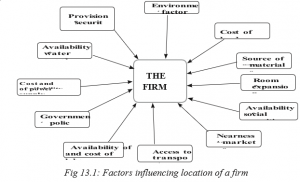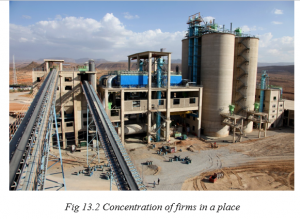A firm refers to a single business unit or enterprise under one ownership, management and contact. It is an independently administered business organisation that makes decision on how to use resources to produce goods and services in order to make profit.
13.1.2 A plant
A plant is a particular facility or building that is used to manufacture a product or produce a substance. Different firms have different plants.
13.1.3 An industry
An industry is made up of several firms that compete in the production of the same product or service. It can be made of a single firm, two firms or very many firms. For example, transport industry in Rwanda is made up of very many vehicles operators such as buses, matatus, airplanes and many others.
13.1.4 Objectives of the firm
Remember!!! The Industrial Revolution is one of the extraordinary jumps forward in the story of civilisation.
Activity 13.4
Basing on the discussion and findings in Activity 13.3, identify some similarities the firms you visited have. In small groups, discuss the objectives of those firms and the factors that influence their long term decisions. Make class presentations.
Different firms have different objectives depending on the size and location. All firms must make an appropriate choice when deciding on which good or service to produce in order to achieve its objectives. But in general, firms have the following objectives:
- Profit maximisation is one of the major objectives of firms.
- Firms have an objective of increasing their share of the market. They have an objective of increasing their sales revenue. iv. They have an objective of limiting entry of new firms in the industry.
- The objective of a firm is to improve the social and economic welfare of its employees.
- Firms have an objective of long run survival in the market.
Remember !! The heart and soul of the firm is creativity and innovation.
13.1.5 Factors influencing long term decisions of the firm
Every firm must put into consideration a number of factors when deciding on which good or service to produce for sale in order to make a maximum profit. This is because the resources available are scarce and every choice made has an opportunity cost. Some of the factors that should be considered include:
- The objective of the firm: A firm will take decisions that are in line with its objectives such as profit maximisation, sales maximisation, long run survival among others.
Government policies on business: Policies like those on taxation, subsidisation influence a firm’s decisions. For example increased taxes on the firm’s products may influence a firm to increase prices or even reduce wages of employees in order to cut cost and remain profitable.
The level of competition: The level of competition will determine the decisions of the firm. For example a firm operating under perfect or pure competition cannot take the same decisions as a monopolistic firm.- Cost of production: A firm has to consider the costs of production in taking its decisions. For example a firm has to consider its average costs when taking decisions concerning determining price for its output.
- Location of the firm: Firms that operate in urban areas will take decisions that are different from those of firms operating from rural areas as the nature of their business environment is different.
- Economic conditions: The economic condition the firm is operating in influences its decisions. Such macro economic conditions such as inflation, unemployment, business cycle will influence the decision taken by the firm.
- Business expectations: What a firm expects in terms of return on its investment affects its decisions regarding planning, marketing and investment decisions among others.
Case study
One Saturday afternoon, five senior four students of Kagarama secondary school visited Utexrwa Textiles, a large tailoring workshop in the market close to their school. This is the shop where their uniforms are bought. They were surprised by the number of customers that came in and out.
Questions
- Would you classify Utexrwa Textiles as a firm or an industry? Explain your answer.
- The firm sells a wide variety of clothes. Explain the factors that the firm considers before settling on the production of particular clothes.
13.2: LOCATION AND LOCALISATION OF FIRMS
Activity 13.5
As an individual student, make a visit to any firm of your choice in any District near your school. Observe the activities that are carried out in the firm. Interact with workers in the firm and if possible ask for a tour around the firm under guidance.
- On your own opinion, what do you think influenced the construction of the firm where it is?
- In groups of not more than five students each, discuss the factors that you think could have influenced the location of the firm you visited.
Discovery
From the activity above, we find that firms are located in different places. The location of a firm becomes a real challenge for entrepreneurs in terms of management strategy. Some firms are located in rural areas while others are in urban centres.
Facts
Location of a firm refers to the physical place where the business operates.
Entrepreneurs choose a location that gives the lowest cost but highest profits.
13.2.1: Factors influencing location of a firm and an industry
- Availability of raw materials: A firm should be located in an area where raw materials are especially when the raw materials are heavy and it would be costly transport them from distant places.
- Availability of the market: Firms should be located in areas where the market for its finished products is available as this reduces the firms expenditure to market its products and hence an increase in firm sales and profits.
- Government policy: The policy of the government concerning industrialisation influences location of firms. For example government may have the goal of regional balance in development and therefore my dictate where to locate certain firms in order to realise this goal.
- Transport and communication network: Firms should be located in areas where the transport and communication infrastructure is developed. This eases transportation of the firm’s products to market and the raw materials to the firm as well as keeping in touch with its partners through efficient communication network.
- Availability of power: Firms should be located in an area where power is available and less costly. This is because every firms need power in the production process and therefore its absence implies that the firm cannot undertake production.
- Availability of labour: A firm should be located in an area where there is availability of abundant labour, with the required skills that the firm can employ to facility its production process.
- Availability of land: Availability of enough land which the firm can acquire at a low cost and also where it can expand its scale of operations in future influences the location the firm.
- Political stability: Firms should be located in an area where there is political stability since it will be sure of the security of its investments.
- Commercial institutions: Presence of developed commercial institutions such as banks, insurance companies and advertising companies. They facilitate the firm to acquire credit and promote its products in case of advertising companies influence location of firms.

Localisation of firms
In today’s economy, firms depend on one another. One firm’s waste material may be used by another firm as a raw material. Due to this interdependency among firms, most entrepreneurs decide to construct their firms near the ones that may provide raw materials. This helps in cutting down the transportation and disposal of waste costs for the firms.

Merits of localisation of firms
- Creation of employment: Localisation leads to creation of more employment opportunities to the population in the area as firms in the area will require workers with varying skills.
- Development of infrastructure: Localisation results into improvement of infrastructure by the government such as roads and telecommunications to cater for the firm’s needs.
- Urbanisation: Concentration of firms in a particular area results into urbanisation. With its advantages like improvement of cultures and attitudes, encouraging hard work hence promotion of economic development.
- Improved quality: Concentration of firms in area results into production of high quality products due to competition among many firms.
- Improved reputation: Localisation enables the area to gain reputation and the same will apply to the goods produced from that area which creates wider markets for its products.
- Supply of skilled labour: Concentration of firms in an area attracts skilled labour to that area which in the long run promotes specialisation and division of labour in the production process with its associated advantages.
- External economies: Concentration of firms in an area results into generation of various external economies like transport economies, marketing economies, labour economies, research economies and many others which reduce the production costs of the different firms.
- Industrial expansion: Localisation of firms results into growth of subsidiary industries to supply raw materials, machine tools, component parts etc hence expansion of the industrial sector.
13.2.4: Demerits of localisation of firms
- Regional imbalances: As a result of localisation, some regions grow faster than others leading to regional imbalances in development. This can lead to friction, social conflicts and other political.
Development of slums: Localisation results into development of slums due to lack of adequate housing facilities to house the large number of people in the localised area

- Rural-urban migration: Due to localisation, many people move to urban centers in search of employment. This results into high crime rates and other social problems in urban areas.
- Social problems: Concentration of firms in an area results into social problems like congestion, overpopulation, traffic jams and accidents which reduce labour efficiency and industrial production.
- Over-straining infrastructure: As a result of localisation, infrastructures like roads are excessively used which increases wear and tear, costs of replacement hence constraining the government budget. Diseconomies: Due to concentration of many firms in an area, diseconomies of scale arise such as high cost of labour, transport problems, failure to secure credit, competition for raw materials resulting into high costs of production.
- Increased cost of living: Concentration of firms in an area results into shortage of essential commodities in the area due to increased demand for those products, hence resulting into increased cost of living.
- Increased dependence: Localisation results into overdependence on a particular area for a particular product which is dangerous in case of war, natural disasters or in an economic crisis.
- Exhaustion of resources: Concentration of firms in an area leads of over exploitation of resources in the area resulting into exhaustion of the resources which deprives the future of access to those resources.
13.2.5: Survival of small scale firms alongside large scale firms
Activity 13.7
In Gikongoro market, Josiane and Family Company have processed fruit juice for the last 10 years. The company has employed Nazou and Manasse only to help them run the business. They can manage to attend to as many clients as possible per day within the market.
In the same county, there is Inyange Industries that manufactures fruit juice. It employs many people from all over Rwanda. It produces over 10000 litres of juice per day. It has also opened up many branches in different cities in Rwanda.
- In your own opinion, identify the reasons why there is a big gap between the amounts of the output produced by the two firms.
- In a class discussion, explain the reasons why Nadege’s firm continues to exist alongside large scale firms like Josiane and Family Company.
Remember!! Small business are the backbone of our economy. I’m for big business, too. But small business are where the jobs are generated.
Although large scale firms enjoy various advantages over small scale firms, small firms continue to established and exist alongside large scale firms. The following factors explain the continued existence and survival of small scale firms alongside large scale firms:
- Management: Small scale firms are easier to manage. They make decisions very fast and efficiently since it is done by few people.
- Fear of rising costs: Some small scale firms simply fear the rising costs associated with large scale production. When small scale firm expands, the owners may start experiencing an increase in cost. This may force them to retain the business as small scale.
- Market limitation: Some firms remain small in the long run due to small size of the market for their products that cannot them to expand.
- Distance between producers: When a firm is separated from its rivals by a long distance it may continue to exist despite its small size.
- Subsidiary industries: Small firms may continue to exist alongside large ones if they act as subsidiaries of the large firms for example repairing machines, using by products and providing other services to the firm.
- Personal services: Firms providing personal services where there is need for personal contact with customers usually remain small in the long run in order to maintain relations with customers such as medical firms, legal firms and many others.

- Desire for independence: Where there is shortage of capital, individuals will continue with small firms where little capital is needed rather than integrating to form large ones due to desire for independence. Banding together: Small firms continue to survive alongside large firms by working as a group while maintaining their independence which enables them to realise economies of large scale production.
- Sub-contracting: Small firms may continue to survive alongside large firms by sub-contracting from the large ones which enables them to get access to markets e.g. construction firms.
- Government policy: In some countries, the laws governing expansion of business are very strict. Small scale firms may fail to meet the conditions hence they remain small.
Unit Summary
- A firm was defined as the smallest unit of production under one control which employs factors of production to produce goods and services.
- Objectives of the firm were also discussed and they include, profit maximisation, sales maximisation, production of quality products, improvement of social economic welfare of employees among others.
- Factors influencing long term decisions of the firm were discussed such as cost of production, business expectations, objective of the firm, government policy, level of competition, planning period, economic conditions among others.
- Factors that influence location of a firm was discussed and they include among others; availability of raw materials, availability of market, government policy, transport and communication network, labour availability among others.
- Localisation was also discussed as the concentration of firms in an area.
- Advantages and disadvantages of localisation were also discussed. The advantages include; production of quality products, increased output, creation of employment opportunities, development of infrastructure, economies of scale etc.
- The disadvantages of localisation include; rural urban migration, development of slums, high cost of living, unemployment, social costs like high crime rates, prostitution, over dependence, diseconomies
of scale, over straining infrastructure, exhaustion of resources, limits employment opportunities among others.
- Factors for survival of small scale firms alongside large ones were also discussed such as limited capital, limited market, long distance between producers, sub-contracting, fear of risks, subsidiary industries, case of personal services, desire for independence, banding together among others.
Unit Assessment 13
- (a) Distinguish between a firm and an industry.
- Explain the factors that influence location of a firm.
- (a) What is meant by localisation of firms?
- Discuss the advantages and disadvantages of localisation of
- Discuss the factors that explain the survival of small scale firms alongside large scale firms.
